International Journal of Computer Network and Information Security @ijcnis
Статьи журнала - International Journal of Computer Network and Information Security
Все статьи: 1177

Big Data Time Series Forecasting Using Pattern Sequencing Similarity
Статья научная
Time series forecasting in big data analytics is crucial for making decisions in a variety of fields. but faces challenges due to high dimensionality, non-stationarity, and dynamic patterns. Conventional approaches frequently produce inaccurate results because they are unable to capture sudden variations and intricate temporal connections. This study proposes a Multi-scale Dynamic Time Warping-based Hierarchical Clustering (MDTWbH) approach to improve forecasting accuracy and scalability. Multi-scale Dynamic Time Warping (MDTW) transforms time series data into multi-scale representations, preserving local and global patterns, while Hierarchical Clustering groups similar sequences for enhanced predictive performance. The proposed framework integrates data preprocessing, outlier detection, and missing value interpolation to refine input data. It employs Apache Hadoop and Spark for efficient big data processing. Long Short Term Memory (LSTM) is applied within each cluster for accurate forecasting, and accuracy, precision, recall, F1-score, MAE, and RMSE are used to assess the performance of the model. Experimental results on electricity demand, wind speed, and taxi demand datasets demonstrate superior performance compared to existing techniques. MDTWbH provides a scalable and interpretable solution for large-scale time series forecasting by efficiently capturing evolving temporal patterns.
Бесплатно
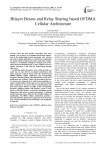
Bilayer Beams and Relay Sharing based OFDMA Cellular Architecture
Статья научная
Over the past decade, researchers have been putting a lot of energy on co-channel interference suppression in the forthcoming fourth generation (4G) wireless networks. Existing approaches to interference suppression are mainly based on signal processing, cooperative communication or coordination techniques. Though good performance has been attained already, a more complex receiver is needed, and there is still room for improvement through other ways. Considering spatial frequency reuse, which provides an easier way to cope with the co-channel interference, this paper proposed a bilayer beams and relay sharing based (BBRS) OFDMA cellular architecture and corresponding frequency planning scheme. The main features of the novel architecture are as follows. Firstly, the base station (BS) uses two beams, one composed of six wide beams providing coverage to mobile stations (MSs) that access to the BS, and the other composed of six narrow beams communicating with fixed relay stations (FRSs). Secondly, in the corresponding frequency planning scheme, soft frequency reuse is considered on all FRSs further. System-level simulation results demonstrate that better coverage performance is obtained and the mean data rate of MSs near the cell edge is improved significantly. The BBRS cellular architecture provides a practical method to interference suppression in 4G networks since a better tradeoff between performance and complexity is achieved.
Бесплатно
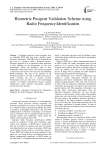
Biometric Passport Validation Scheme using Radio Frequency Identification
Статья научная
Biometric passports issued nowadays have an embedded RFID chip that carries digitally signed biometric information. This RIFD chip is integrated into the cover of a passport, called a biometric passport. Electronic passports as it is sometimes called, represents a bold initiative in the deployment of two new technologies: RIFD and biometrics such as face, fingerprints, palm prints and iris. The electronic passport is the privacy and security risks that arise by embedding RFID technology. The goal of the adoption of the biometric passport is not only to expedite processing at border crossings, but also to increase security. Policymakers have put their faith in the technological promise of biometric identification because absolute identification could eliminate mismatched computer records and stolen identities.
Бесплатно
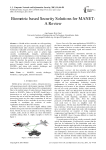
Biometric based Security Solutions for MANET: A Review
Статья научная
Mobile ad hoc networks are self organizing, infrastructure-less, low power networks, design to deploy bandwidth-shared radio channel communication and to work under vulnerable environment. Security is primary concern in MANETs and in order to achieve high security (confidentiality, integrity, authentication, availability and non repudiation), several techniques have been explored in which biometrics with cryptography or intrusion detection has gained a momentum in recent years. This paper critically reviews and investigates the present biometric based security models works for MANETs, and along with security challenges and direction of further research are proposed.
Бесплатно
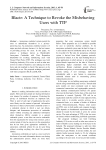
Blactr: A Technique to Revoke the Misbehaving Users with TTP
Статья научная
Anonymous credential systems permit the users to authenticate themselves in a privacy-preserving way. An anonymous credential system is of major practical relevance because it is the best means of providing privacy for users. In this paper, we propose a technique known as Blacklistable Anonymous Credentials with Trust Reputation (BLACTR) for revoking misbehaving users with Trusted Third Party (TTP). The technique uses both Certifying Authority (CA) review as well as other user reviews in order to blacklist a user making use of the fuzzy and rule matched to check if the person is to be blacklisted or not. The proposed technique performed well when compared to BLAC and BLACR.
Бесплатно
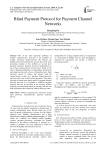
Blind payment protocol for payment channel networks
Статья научная
One of the most important problems of modern cryptocurrency networks is the problem of scaling: advanced cryptocurrencies like Bitcoin can handle around 5 transactions per second. One of the most promising solutions to this problem are second layer payment protocols: payment networks implemented on top of base cryptocurrency network layer, based on the idea of delaying publication of intermediate transactions and using base network only as a finalization layer. Such networks consist of entities that interact with the cryptocurrency system via a payment channel protocol, and can send, receive and forward payments. This paper describes a formal actor-based model of payment channel network and uses it to formulate a modified payment protocol that can be executed in the network without requiring any information about its topology and thus can hide information about financial relations between nodes.
Бесплатно
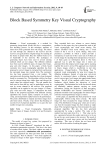
Block Based Symmetry Key Visual Cryptography
Статья научная
Visual cryptography is a method for protecting image-based secrets that has a computation-free decoding process. In this technique, numbers of shares have been generated from one image. The shares are sent through any channel to the receiver and the receiver can again produce original image by stacking all the shares in proper order. But, this method wastes a lot of bandwidth of the network. The techniques of generating shares have been used in several existing methods which are not unique. The different methods have been used in different types of images like binary, gray and color images. In this paper, a block based symmetry key visual cryptography algorithm has been proposed to convert image in encrypted form and decrypt the encrypted image into original form. The symmetric key has been generated from a real number. The encryption and decryption algorithm have been designed based on symmetry key. The algorithm with key has been used to encrypt image into single share and decrypt the single share into original image. The real number has been used to form the key may be predefined or may be sent by secure channel to the receiver. The proposed algorithm can be applied to any type images i.e. binary, gray scale and color images. A comparison has been made of the proposed algorithm with different existing algorithms like Ceaser cipher, transpose of matrix, bit comp, and transposition cipher based on the performance. The pixels distributed in original and share images have also been tested. Finally, it has shown that breaking of security level of proposed algorithm i.e. to guess the real number is huge time consuming.
Бесплатно
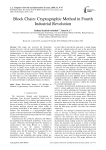
Block chain: cryptographic method in fourth industrial revolution
Статья научная
This paper has reviewed the blockchain domain that suits with the current Industrial Revolution (Industry 4.0) uses cryptographic method blockchain. The implementation of this new cryptographic method in Industry 4.0 is currently being used widely as it eases the process of financial transaction and other process that have been as issue related with cyber security. The collection of review papers shows that the blockchain technology has high potential to grow wider not just in financial technology services and manufacturing industry but also in public sector, health care and even media industry. The papers elaborate how the blockchain able to be applied in different fields of technology in order make a secure and more protected services without entrusted the third party to avoid vulnerability to be attacked and misused. Nevertheless, the applications of the blockchain in various field helps in making the industry revolution.
Бесплатно
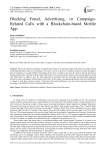
Blocking Fraud, Advertising, or Campaign-Related Calls with a Blockchain-based Mobile App
Статья научная
The use of a person's cell phone to commit fraud is known as cell phone fraud. Such scams are usually carried out through fake phone calls or text messages. The victim receives a call from a cell phone scammer, usually claiming to have an emergency or a legal problem. The purpose of the scam is usually to convince the victim to provide personal or financial information. This may include private information such as social security numbers, bank account details or credit card information. In addition, users are often subjected to unsolicited calls for marketing and information gathering initiatives such as campaigns, advertisements and surveys. In this study, a smartphone application built on the blockchain is created to stop these nuisance actions. Transaction times and performance tests have been rigorously performed according to the difficulty levels of the blockchain structure.
Бесплатно
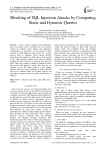
Blocking of SQL Injection Attacks by Comparing Static and Dynamic Queries
Статья научная
Due to internet expansion web applications have now become a part of everyday life. As a result a number of incidents which exploit web application vulnerabilities are increasing. A large number of these incidents are SQL Injection attacks which are a serious security threat to databases which contain sensitive information, the leakage of which cause a large amount of loss. SQL Injection Attacks occur when an intruder changes the query structure by inserting any malicious input. There are a number of methods available to detect and prevent SQL Injection Attacks. But these are too complex to use. This paper proposes a very simple, effective and time saving technique to detect SQLIAs which uses combined static and dynamic analysis and also defines an attack other than existing classification of SQLIAs.
Бесплатно
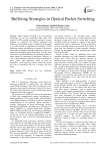
Buffering Strategies in Optical Packet Switching
Статья научная
Optical packet switching is one of promising technology for the next generation high speed data transfer. In OPS contention among the packets is a major problem, to counteract the problem deflection and buffering of contending packets is proposed. In this paper, a six node network is considered and usability of both deflection routing and buffering of packets is discussed. The results are obtained through simulations, in terms of packet loss probability and average delay. This has been found that in general buffering of contending packets is better option in comparison to deflection. However, in case of load balancing, deflection routing is desirable as some packets take alternative routes to reach its destination. Load balancing scheme reduces the packet loss rate at contending node but it increases the total delay.
Бесплатно
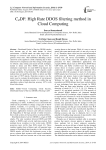
C2DF: High Rate DDOS filtering method in Cloud Computing
Статья научная
Distributed Denial of Service (DDOS) attacks have become one of the main threats in cloud environment. A DDOS attack can make large scale of damages to resources and access of the resources to genuine cloud users. Old-established defending system cannot be easily applied in cloud computing due to their relatively low competence and wide storage. In this paper we offered a data mining and neural network technique, trained to detect and filter DDOS attacks. For the simulation experiments we used KDD Cup dataset and our lab datasets. Our proposed model requires small storage and ability of fast detection. The obtained results indicate that our model has the ability to detect and filter most type of TCP attacks. Detection accuracy was the metric used to evaluate the performance of our proposed model. From the simulation results, it is visible that our algorithms achieve high detection accuracy (97%) with fewer false alarms.
Бесплатно
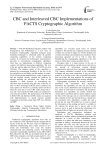
CBC and Interleaved CBC Implementations of PACTS Cryptographic Algorithm
Статья научная
PACTS (Parallelized Adaptive Cipher with Transposition and Substitution) is a new class of Symmetric Cryptographic Algorithm designed using traditional techniques to efficiently utilize the parallel computing capabilities of the modern computing systems. It overcomes the performance inconsistencies prevalent in conventional cryptographic algorithms when they are implemented in different computing systems with different processing capabilities. The size of the key and the plain text blocks of PACTS are each 1024-bits. The adaptive nature of this algorithm is achieved by incorporating flexibility in the size of the key and plain text sub-blocks and the number of rounds. Level of Intra-packet parallelization, variety in grain size and the required security strength are achieved by suitably deciding the sub-block size. Flow of the algorithm is made dynamic by determining the execution steps at runtime using the value of the key. In spite of these advantages PACTS always produces the same cipher text block for a particular plain text block when the same key is used. CBC mode along with 2-way and 4 way Interleaved CBC modes are employed to overcome this problem. The performance of the PACTS in ECB, CBC and Interleaved CBC modes are analyzed with implementations in shared memory parallel computing environment using OpenMP, Java Threads and MPI.
Бесплатно
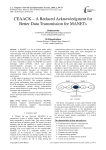
CEAACK – A Reduced Acknowledgment for Better Data Transmission for MANETs
Статья научная
fvA MANET is a set of mobile nodes which works in a dynamic changing network and it is capable of communicating with each other efficiently where all the nodes perform a dual role as that of a transmitter and a receiver. Hence MANETs do not use any centralized administration for communication due to this reason they are more vulnerable to attacks. So MANET uses special technique called EAACK, which uses special acknowledgment messages to avoid intruder communication. So due to this type of authentication, more acknowledgment messages are transferred in between two nodes, which increases delay in communication. Hence this drawback reduces system performance. In this paper we propose a new clustering technique in EAACK called CEAACK. Our proposed technique shows better performance when compare to the normal EAACK technique, which drastically reduces the number of acknowledgment packets during authentication process which achieves a good energy efficiency network and better data transmission. Further, this technique consumes low energy and in the process provides better efficiency in data transmission in MANETs.
Бесплатно
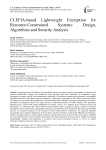
Статья научная
Emerging classes of distributed and embedded systems increasingly require cryptographic mechanisms that provide confidentiality, integrity, and authenticity while operating under strict limitations on computation, energy consumption, memory capacity, and communication bandwidth. Conventional symmetric and asymmetric cryptographic algorithms often fail to meet these stringent requirements. Lightweight cryptography (LWC) offers a promising solution by enabling secure real-time data transmission, command authentication, telemetry encryption, and protection of sensitive information in embedded systems. This paper presents a multicriteria analysis of widely adopted LWC algorithms, identifying the CLEFIA block cipher standardized in ISO/IEC 29192-2 as a balanced choice between security and performance. An enhanced LWC method based on the mentioned cipher is proposed, aiming to improve encryption throughput without compromising cryptographic robustness. Experimental results demonstrate that the proposed method achieves an encryption speedup over the baseline CLEFIA implementation. Furthermore, the improved algorithm successfully passes statistical randomness tests and shows increased resistance to linear and differential cryptanalysis. Notably, the cipher begins to exhibit random substitution characteristics from the third round, reinforcing its suitability for secure deployment in resource-limited environments. The results obtained in this study will be valuable for ensuring confidentiality, integrity, and authenticity in low-power and resource-constrained systems, as well as in modern information platforms where low latency is critical.
Бесплатно
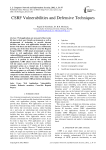
CSRF Vulnerabilities and Defensive Techniques
Статья научная
Web applications are now part of day to day life due to their user friendly environment as well as advancement of technology to provide internet facilities, but these web applications brought lot of threats with them and these threats are continuously growing, one of the these threat is Cross Site Request Forgery(CSRF). CSRF attack is immerged as serious threat to web applications which based on the vulnerabilities present in the normal request response pattern of HTTP protocol. It is difficult to detect and hence it is present in most of the existing web applications. CSRF attack occurs when a malicious web site causes a user’s web browser to perform an unwanted action on a trusted site. It is listed in OWASP’s top ten Web Application attacks list. In this survey paper we will study CSRF attack, CSRF vulnerabilities and its defensive measures. We have compared various defense mechanisms to analyse the best defense mechanism. This study will help us to build strong and robust CSRF protection mechanism.
Бесплатно
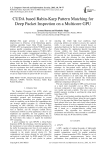
CUDA based Rabin-Karp Pattern Matching for Deep Packet Inspection on a Multicore GPU
Статья научная
This paper presents a study of the improvement in efficiency of the Rabin-Karp pattern-matching algorithm based Deep Packet Inspection. NVIDIA GPU is programmed with the NVIDIA's general purpose parallel computing architecture, CUDA, that leverages the parallel compute engine in NVIDIA GPUs to solve many complex computational problems in a more efficient way than on a CPU. The proposed CUDA based implementation on a multicore GPU outperforms the Intel quadcore processor and runs upto 14 times faster by executing the algorithm in parallel to search for the pattern from the text. The speedup may not sound exorbitant but nonetheless is significant, keeping in view that the experiments have been conducted on real data and not synthetic data and, optimal performance even with the huge increase in traffic was the main expectation, not just an improvement in speed with few test cases.
Бесплатно
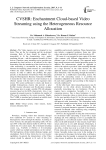
CVSHR: Enchantment Cloud-based Video Streaming using the Heterogeneous Resource Allocation
Статья научная
The Video requests can be streamed in two forms. They are the live streaming and the on-demand streaming. Both of them should be adapted (I.e., transcoded) to fit the characteristics (e.g., spatial resolution, bit rate… and the supported formats) of client devices. Therefore, many streaming service providers are presented the cloud services to be utilized in the video transcoding. But, the introducing of the cloud services for video transcoding is encountered by the contradiction between the deploying cloud resources in a cost-ef?cient without any major influence on the quality of video streams. In order to address this problem, this paper presents an Enchantment Cloud-based Video Streaming using the Heterogeneous Resource Allocation (CVSHR) to transcode the video streams on cloud resources in an efficient manner with the QoS of the requested video stream. The system architecture is elastic and based on multiple heterogeneous clusters that provide a great flexible resource allocation and De-allocation strategy. This strategy aims to assign a suitable VM with adequate resources based on the GOPs characteristic. Also, it can reassign the unused resources. In addition, the number of VMs can be extended as the system necessity. Finally, The CVSHR is simulated and evaluated on truthful cloud resources and various workload circumstances.
Бесплатно
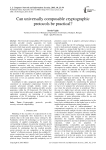
Can universally composable cryptographic protocols be practical?
Статья научная
The Universal Composability (UC) framework provides provable security guaranties for harsh application environment, where we want to construct protocols which keep security guarantees even when they are concurrently composed with arbitrary number of arbitrary (even hostile) protocols. This is a very strong guarantee. The UC-framework inherently supports the modular design, which allows secure composition of arbitrary number of UC-secure components with an arbitrary protocol. In contrast, traditional analysis and design is a stand alone analysis where security of a single instance is considered, i.e. an instance which is not in potential interaction with any concurrent instances. Furthermore, a typical traditional analysis is informal, i.e. without a formal proof. In spite of these facts, beyond the task of key-exchange this technology have not really took the attention of the community of applied cryptography. From practitioner's point of view the UC-world may seem more or less an academic interest of theoretical cryptographers. Accordingly we take a pragmatic approach, where we concentrate on meaningful compromises between the assumed adversarial strength, ideality wishes and realization complexity while keeping provable security guarantees within the UC-framework. We believe that even modest but provable goals (especially, if tunable to application scenarios) are interesting if a wider penetration of the UC-technology is desired into the daily-practice of protocol applications.
Бесплатно
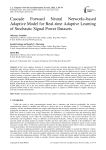
Статья научная
In this work, adaptive learning of a monitored real-time stochastic phenomenon over an operational LTE broadband radio network interface is proposed using cascade forward neural network (CFNN) model. The optimal architecture of the model has been implemented computationally in the input and hidden units by means of incremental search process. Particularly, we have applied the proposed adaptive-based cascaded forward neural network model for realistic learning of practical signal data taken from an operational LTE cellular network. The performance of the adaptive learning model is compared with a benchmark feedforward neural network model (FFNN) using a number of measured stochastic SINR datasets obtained over a period of three months at two indoors and outdoors locations of the LTE network. The results showed that proposed CFNN model provided the best adaptive learning performance (0.9310 RMSE; 0.8669 MSE; 0.5210 MAE; 0.9311 R), compared to the benchmark FFNN model (1.0566 RMSE; 1.1164 MSE; 0.5568 MAE; 0.9131 R) in the first studied outdoor location. Similar robust performances were attained for the proposed CFNN model in other locations, thus indicating that it is superior to FFNN model for adaptive learning of real-time stochastic phenomenon.
Бесплатно

